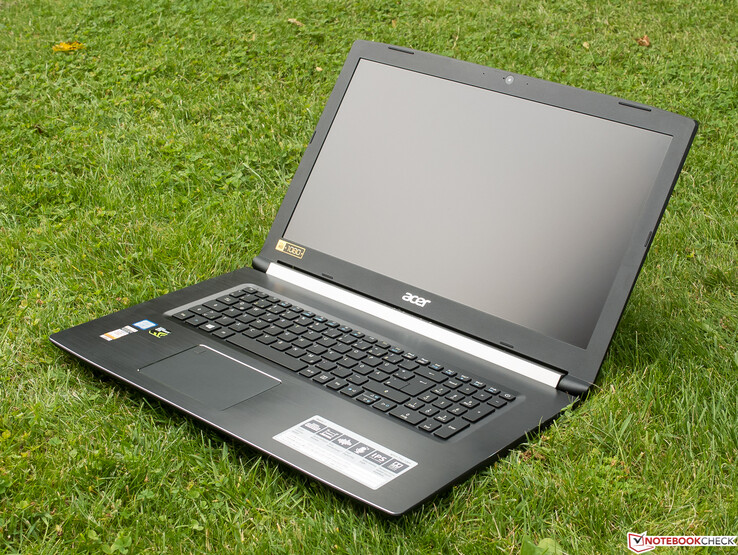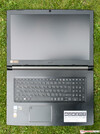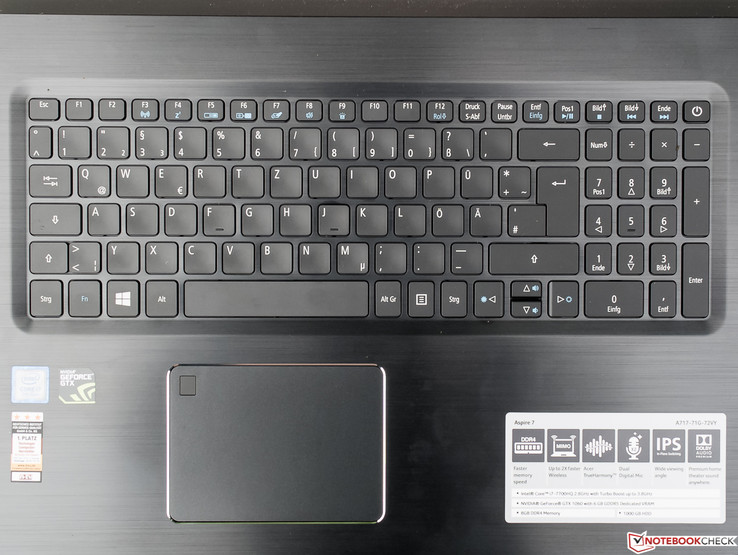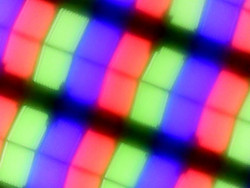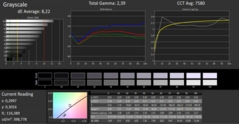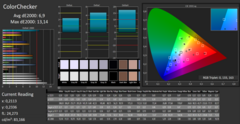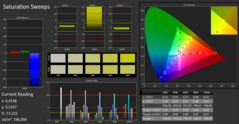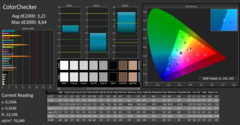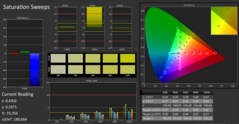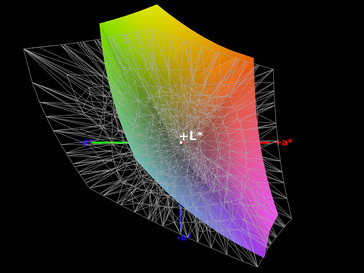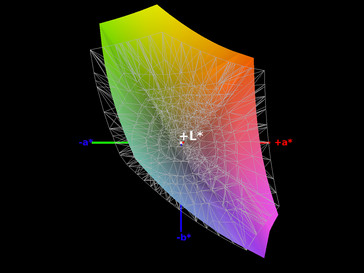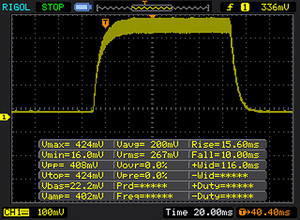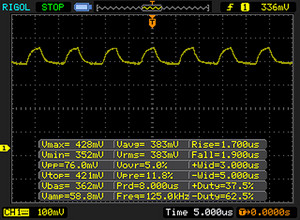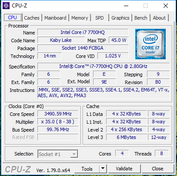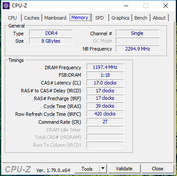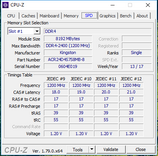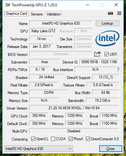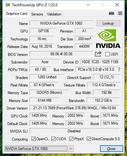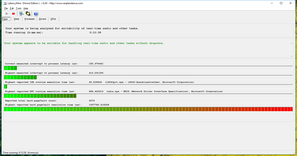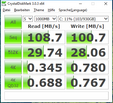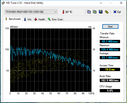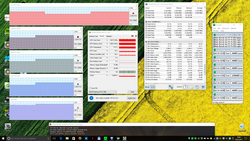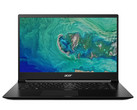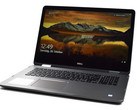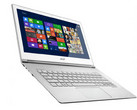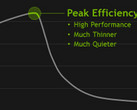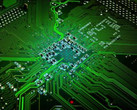Acer Aspire 7 (Core i7, GTX 1060) Laptop Review

For the original German review, see here.
Despite the fact that the GeForce GTX 1060 and the Core i7-7700HQ are strong indicators of a gaming machine, Acer positions its latest Aspire 7 A717-71G-72VY as a multimedia all-rounder. The entire Aspire line-up (3, 5, and 7) is brand-new, so there is no predecessor to compare it to. What the Aspire 7 lacks in comparison to “real” gaming notebooks made by Schenker, Asus, MSI, Alienware, and Acer’s own Predator series are features such as G-Sync, an RGB backlight for the keyboard, programmable macro and additional modifier keys, and software for tuning and overclocking.
Our review unit that sells in Europe for 1400 Euros (~$1651) weighs in at 2.9 kg (~6.4 lb), and its hardware is pretty standard. For example, while the 8 GB of RAM the A717 is equipped with is plenty for most of today’s games, many gaming notebooks come with twice as much or more for a reason. The largest drawback is the total lack of SSD-based storage, while ports like Thunderbolt 3, DisplayPort, or USB 3.1 Gen. 2 can almost never be found on gaming notebooks in this price range. The display is not great either, but at least it is an FHD IPS display that will suit most gamers just fine.
Unlike 15-inch gaming notebooks there are not that many 17-inch competitors so we had to limit ourselves to two rivals. In addition to size our main focus was on somewhat comparable price and performance. Thus, the Aspire 7’s two main competitors are:
Case
It instantly became quite clear that Acer has not spent any resources making the notebook smaller. The mostly black Aspire 7 A717-71G-72VY is incredibly large, and its display is surrounded by very wide bezels. The lid and the base unit’s top cover have a cold metal-like feel and are quite susceptible to fingerprints with their brushed metal surface. As can be seen on the photos below, we have had trouble wiping the fingerprints off the surface. The rest of the case is made of nonslip plastic. Accentuations include the silver Acer logo on the lid, ornamental strips around the base and touchpad, and the eye-catching silver Aspire-series hinge.
The base is very sturdy and rigid, and only flexed minimally under intense force, but remained completely quiet. The thick and pressure-resistant lid is very rigid as well, and barely reacts to torsional forces. The hinge is incredibly tight. So much so that it lifts the entire base when opened. On the plus side, teetering is practically non-existent. Given the largely stationary nature of the beast, the engineers at Acer have failed to get their priorities straight. We have no complaints in terms of overall build quality – gaps are very consistent and narrow, and the protruding edges around the hinge seem to be design elements rather than manufacturing defect. All things considered, the case is rigid and solid without extra bling, but certainly not particularly presentable.
All three competitors weigh around 3 kg (~6.6 lb) and are roughly the same size. The HP Omen is the smallest of the trio, but also the thickest (2 mm/~0.08 in more than our review unit and 5 mm/~0.2 in thicker than the Acer Aspire Nitro). The latter is only a few millimeters wider and deeper than the Aspire 7.
Connectivity
As mentioned before, connectivity is one of the Aspire 7’s weak points. Two of the four USB ports are only USB 2.0, but at least one of the remaining USB 3.1 Gen. 1 ports features a USB Type-C connector. A fold-out Ethernet port is available, as is a full-sized HDMI port. Most gaming headsets will not work on the Aspire 7 due to its single 3.5 mm combo audio jack that is rather uncommon on gaming notebooks. The ports are positioned towards the rear on both sides of the laptop where protruding elements and cables are not as bothersome as they would be up front.
SD Card Reader
Apparently, the Aspire 7’s SD card reader is connected via USB 3.0 (same as on the HP Omen) but cannot keep up with the latter in the real-world JPEG copy test when benchmarked with our 64 GB Toshiba Exceria Pro SDXC UHS-II reference card. Still, it easily managed to beat the downright lethargic USB 2.0 card reader on the Aspire Nitro.
| SD Card Reader | |
| average JPG Copy Test (av. of 3 runs) | |
| HP Omen 17-w206ng (Toshiba Exceria Pro SDXC 64 GB UHS-II) | |
| Acer Aspire 7 A717-71G-72VY (Toshiba Exceria Pro SDXC 64 GB UHS-II) | |
| Acer Aspire V17 Nitro BE VN7-793G-52XN (Toshiba Exceria Pro SDXC 64 GB UHS-II) | |
| maximum AS SSD Seq Read Test (1GB) | |
| HP Omen 17-w206ng (Toshiba Exceria Pro SDXC 64 GB UHS-II) | |
| Acer Aspire 7 A717-71G-72VY (Toshiba Exceria Pro SDXC 64 GB UHS-II) | |
| Acer Aspire V17 Nitro BE VN7-793G-52XN (Toshiba Exceria Pro SDXC 64 GB UHS-II) | |
Communication
The Atheros/Qualcomm QCA 6174 modem cannot keep up with the likes of an Intel dual-band Wireless-AC 8260 module, and its transfer rates were very far from the theoretical maximum of 867 Mbps minus overhead. Accordingly, it was significantly slower than most MIMO 2x2 Wi-Fi modems, but that might not be the wireless modem acting up but the antennas. Our measurements were performed at a distance of 1 m (~3 ft) to our Linksys EA8500 reference router.
| Networking | |
| iperf3 transmit AX12 | |
| Acer Aspire V17 Nitro BE VN7-793G-52XN | |
| HP Omen 17-w206ng | |
| Acer Aspire 7 A717-71G-72VY | |
| iperf3 receive AX12 | |
| HP Omen 17-w206ng | |
| Acer Aspire V17 Nitro BE VN7-793G-52XN | |
| Acer Aspire 7 A717-71G-72VY | |
Security
To our surprise, Acer has decided to not only include a TPM 2.0 chip, but also a fingerprint reader, which is located in the upper left corner of the touchpad and turned out to be very reliable and fast.
Accessories
Budget notebook, budget accessories – also known as no accessories at all. The barren box oh-so common for most Acer notebooks these days contained no extras apart from the charger and the usual quick start guide and warranty leaflet. Accessories made specifically for the Aspire 7 do not exist.
Maintenance
Given that the bottom cover is very high and extends pretty much all the way to the top cover and the number of screws that must be removed, we would assume that disassembly is a rather arduous task. Most probably, the top cover has to be lifted out of the bottom pan. Fortunately, the Aspire 7 is equipped with two maintenance hatches for the hard drive and the RAM slots.
According to some dealers, the Aspire 7 is supposed to be equipped with a free PCIe 3.0 M.2 slot, which we were unable to verify. We have refrained from taking the notebook apart due to the fact that it was a shop unit. However, the model currently on offer in the US (A717-71G-735Q) is equipped with a 1 TB hard disk and an additional SSD drive.
Warranty
As usual, devices sold in Europe come with a 2-year bring-in limited warranty while devices sold in the US are limited to a 1-year limited warranty. Please see our Guarantees, Return policies and Warranties FAQ for country-specific information.
Input Devices
Keyboard
The pressure-resistant keyboard is almost as wide as a standard desktop keyboard and narrower by only a few millimeters. Yet, despite more space than necessary the number pad is once again smaller than on standard keyboards, which is going to be rather uncomfortable for users with large hands. Apart from that, the size and spacing of the somewhat concave and slightly roughened keys is decent and touch-typists should get along just fine. As is quite common in Acer notebooks, the layout is very close to the standard keyboard layout. Only the bottom row is different: due to the arrow keys, keys such as CTRL and ALT are either just as large as the other keys or even smaller.
We did not like the keyboard’s feedback: it felt very spongy and soft. Most keys are decently quiet, only the larger keys such as the space bar or the return key clatter noticeably. The backlight can only be turned on or off, and could have been a bit brighter.
Touchpad
The touchpad framed by a silver ornamental strip is sufficiently large, but is placed too far left where it can get in the way of a hand resting on the WASD keys. It offered decent sliding properties even with slightly moist fingers, but did not detect movement or inputs at its edges. Precision and response times were more than decent, and fast movements were detected reliably every time. Drag & drop via double-tap worked every time.
Unfortunately, the touchpad was not flush with the case and clattered noticeably. The two buttons on the other hand, were decent and worked very well with their rather tight, but nicely balanced resistance and their very clear acoustic and tactile feedback. Due to the absence of dedicated touchpad software, gestures are limited to what Windows 10 is capable of configuring (basic gestures with up to three fingers).
Display
The 17.3-inch matte FHD IPS display’s maximum brightness of 357 nits was excellent, and significantly brighter than both its competitors that were measured at around 300 nits. The display’s brightness distribution of 86% was decent, but we did notice some minor screen bleeding around the edges, and blacks were thus not entirely homogenous. Having said that, this was only an issue on all-black display contents; as soon as bright areas were included on-screen, the screen bleeding became unnoticeable.
Due to the rather low pixel density of only 127 PPI, the screen contents seemed somewhat coarse pixilated up close. Crispness was top notch, though. Acer does not offer any other display options for the Aspire 7.
| |||||||||||||||||||||||||
Brightness Distribution: 86 %
Center on Battery: 382 cd/m²
Contrast: 1005:1 (Black: 0.38 cd/m²)
ΔE ColorChecker Calman: 6.9 | ∀{0.5-29.43 Ø4.78}
ΔE Greyscale Calman: 8.22 | ∀{0.09-98 Ø5}
85% sRGB (Argyll 1.6.3 3D)
56% AdobeRGB 1998 (Argyll 1.6.3 3D)
62.3% AdobeRGB 1998 (Argyll 3D)
85.2% sRGB (Argyll 3D)
66.2% Display P3 (Argyll 3D)
Gamma: 2.39
CCT: 7580 K
| Acer Aspire 7 A717-71G-72VY LG Philips LGD056D / LP173WF4-SPF5, , 1920x1080, 17.3" | HP Omen 17-w206ng Chi Mei CMN1738, , 1920x1080, 17.3" | Acer Aspire V17 Nitro BE VN7-793G-52XN AUO B173HAN01.0, , 1920x1080, 17.3" | |
|---|---|---|---|
| Display | 6% | 3% | |
| Display P3 Coverage (%) | 66.2 | 67.2 2% | 64 -3% |
| sRGB Coverage (%) | 85.2 | 93.1 9% | 90.2 6% |
| AdobeRGB 1998 Coverage (%) | 62.3 | 67.4 8% | 65.4 5% |
| Response Times | 2% | 4% | |
| Response Time Grey 50% / Grey 80% * (ms) | 41 ? | 38 ? 7% | 36 ? 12% |
| Response Time Black / White * (ms) | 25 ? | 26 ? -4% | 26 ? -4% |
| PWM Frequency (Hz) | 125000 ? | 200 ? | |
| Screen | 14% | 16% | |
| Brightness middle (cd/m²) | 382 | 318 -17% | 346 -9% |
| Brightness (cd/m²) | 357 | 295 -17% | 307 -14% |
| Brightness Distribution (%) | 86 | 79 -8% | 84 -2% |
| Black Level * (cd/m²) | 0.38 | 0.25 34% | 0.26 32% |
| Contrast (:1) | 1005 | 1272 27% | 1331 32% |
| Colorchecker dE 2000 * | 6.9 | 4.7 32% | 4.32 37% |
| Colorchecker dE 2000 max. * | 13.14 | 8.8 33% | 8.05 39% |
| Greyscale dE 2000 * | 8.22 | 5 39% | 5.76 30% |
| Gamma | 2.39 92% | 2.28 96% | 2.35 94% |
| CCT | 7580 86% | 7374 88% | 6447 101% |
| Color Space (Percent of AdobeRGB 1998) (%) | 56 | 61 9% | 59 5% |
| Color Space (Percent of sRGB) (%) | 85 | 93 9% | 90 6% |
| Total Average (Program / Settings) | 7% /
11% | 8% /
11% |
* ... smaller is better
At 0.38 nits, black levels were decent, but not as good as on both competitors. Nevertheless, the display’s high brightness ensures a decent contrast ratio of 1005:1. But while both the Omen and the Aspire Nitro were not as bright as the Aspire 7, they offered 27 and 32% higher contrast ratios respectively, due to their lower black levels. Consequently, the appeal of a black full-screen picture was only mediocre at best.
Color accuracy was pretty poor. DeltaE deviations of 8.22 for gray scales and 6.9 for colors were further off from the optimum value of 3 than on the Omen and the Aspire Nitro. This was noticeably improved through calibration with a photospectrometer and the CalMAN software, and we managed to achieve values of 0.83 and 3.21 for gray scales and colors, respectively. Nevertheless, the LG-Philips panel was unable to keep up with its competition when it came to Yellow and Orange colors, and DeltaE deviation for these remained very high at 8.64. The violet tint that plagued the display out of the box was all but eliminated through calibration. As usual, the resulting ICC profile can be found for download in the box above.
The Aspire 7 is not suitable for photo editing, not only because of its inaccurate representation of colors, but also because of its low color space coverage of just 85% sRGB and 56% AdobeRGB. Both its competitors had higher coverage ratios of 93 and 90%, respectively, but even those are inadequate for (semi-) professional photo editing ambitions.
The outdoor test was performed while overcast. The left photo was taken with the screen pointing directly at the sky and although overall usability was somewhat reduced, the screen was still readable. In direct sunlight, the screen would have been rendered unreadable, despite its matte surface and high brightness. The right photo represents the ideal position with the display pointed at a house entrance, and it would have looked almost identical in bright sunlight.
Display Response Times
| ↔ Response Time Black to White | ||
|---|---|---|
| 25 ms ... rise ↗ and fall ↘ combined | ↗ 15 ms rise | |
| ↘ 10 ms fall | ||
| The screen shows relatively slow response rates in our tests and may be too slow for gamers. In comparison, all tested devices range from 0.1 (minimum) to 240 (maximum) ms. » 58 % of all devices are better. This means that the measured response time is worse than the average of all tested devices (20.2 ms). | ||
| ↔ Response Time 50% Grey to 80% Grey | ||
| 41 ms ... rise ↗ and fall ↘ combined | ↗ 22 ms rise | |
| ↘ 19 ms fall | ||
| The screen shows slow response rates in our tests and will be unsatisfactory for gamers. In comparison, all tested devices range from 0.165 (minimum) to 636 (maximum) ms. » 64 % of all devices are better. This means that the measured response time is worse than the average of all tested devices (31.6 ms). | ||
Screen Flickering / PWM (Pulse-Width Modulation)
| Screen flickering / PWM detected | 125000 Hz | ≤ 90 % brightness setting | |
The display backlight flickers at 125000 Hz (worst case, e.g., utilizing PWM) Flickering detected at a brightness setting of 90 % and below. There should be no flickering or PWM above this brightness setting. The frequency of 125000 Hz is quite high, so most users sensitive to PWM should not notice any flickering. In comparison: 53 % of all tested devices do not use PWM to dim the display. If PWM was detected, an average of 8108 (minimum: 5 - maximum: 343500) Hz was measured. | |||
For a modern IPS panel, the Aspire 7’s viewing angles were only mediocre at best, but still more than decent. Starting at around 45 ° horizontally, both brightness and contrast were starting to suffer with colors remaining largely unaffected. Vertically, this effect was less pronounced, but color representation suffered more prominently in return. All in all, viewing angles were decent and we doubt that anyone will feel restricted in their movement in front of the screen.
Performance
Processor
The Core i7-7700HQ (4x 2.8 – 3.8 GHz, Hyperthreading, 45 W TDP) quad-core that our review unit was equipped with is the gaming equivalent to the mainstream office notebook Intel Core i5-7200U CPU; like its predecessor, the i7-6700U (4 x 2.6 – 3.5 GHz), it is quite common in mainstream gaming notebooks. Thanks to the higher clock speeds, the newer Kaby Lake CPUs are generally up to 15% faster than its predecessor. The highly energy-efficient integrated Intel HD 630 GPU is used for less demanding tasks thanks to Nvidia’s Optimus technology, and the processor also features a DDR4 memory controller.
Most current games benefit immensely from four or more physical cores. To allow the GPU to run at peak performance, the CPU should never be the limiting factor in gaming notebooks, and the i7-7700HQ is the perfect CPU for that task and will remain so for the foreseeable future. Given its gaming prowess, everyday tasks such as Office suites or Adobe Photoshop are no problem at all for this CPU. More info and various benchmarks can be found in our FAQs.
We use Cinebench to cause a high, yet realistic CPU load for a prolonged period of time. As can be seen in the graph above, the i7-7700HQ performed as expected throughout the entire benchmark loop. The scores dropped from 726 to 601 points on battery (-17%) due to reduced clock frequencies, from 3.4 to 2.8 GHz.
System Performance
Despite its slower GPU, the HP Omen 17 outperformed both Acer notebooks in the PCMark 8 benchmark while the Aspire 7 came in last. Generally speaking, the faster the storage device, the better the PCMark 8 score: our review unit (third place) was equipped with a regular hard disk drive, the Aspire Nitro (second place) came with a SATA III SSD, and the HP Omen (first place) with a blazingly fast PCIe NVMe SSD.
Subjectively, the overall performance suffered noticeably from the lack of SSD storage. Installing and launching applications took much longer than we were used to, and the system felt rather sluggish in general. Thus, those of us who are already used to working with SSDs will feel let down. When running games, the low storage performance slowed down the initial launch times, but the gaming experience itself was not affected by the slow hard disk drive at all.
| PCMark 8 | |
| Home Score Accelerated v2 | |
| HP Omen 17-w206ng | |
| Acer Aspire V17 Nitro BE VN7-793G-52XN | |
| Acer Aspire 7 A717-71G-72VY | |
| Work Score Accelerated v2 | |
| Acer Aspire V17 Nitro BE VN7-793G-52XN | |
| Acer Aspire 7 A717-71G-72VY | |
| PCMark 8 Home Score Accelerated v2 | 3687 points | |
| PCMark 8 Work Score Accelerated v2 | 4636 points | |
Help | ||
Storage Devices
| Acer Aspire 7 A717-71G-72VY Toshiba MQ01ABD100 | HP Omen 17-w206ng Samsung PM961 MZVLW256HEHP | Acer Aspire V17 Nitro BE VN7-793G-52XN SK Hynix HFS256G39TND-N210A | |
|---|---|---|---|
| CrystalDiskMark 3.0 | 24522% | 13109% | |
| Read Seq (MB/s) | 108.7 | 1606 1377% | 493.1 354% |
| Write Seq (MB/s) | 100.7 | 1176 1068% | 270.2 168% |
| Read 512 (MB/s) | 29.74 | 846 2745% | 325.8 995% |
| Write 512 (MB/s) | 28.06 | 805 2769% | 267.8 854% |
| Read 4k (MB/s) | 0.345 | 59.9 17262% | 28.4 8132% |
| Write 4k (MB/s) | 0.78 | 155.6 19849% | 76.2 9669% |
| Read 4k QD32 (MB/s) | 0.688 | 588 85365% | 344.6 49987% |
| Write 4k QD32 (MB/s) | 0.767 | 505 65741% | 267 34711% |
GPU Performance
The Nvidia GeForce GTX 1060 GPU is the third-fastest currently available Nvidia GPU after the GTX 1080 and GTX 1070 (and their respective Max-Q variants). Based on Nvidia’s current Pascal architecture, it is equipped with 6 GB of effectively 8000 MHz fast GDDR5-VRAM with a 192-bit bus interface. The 16 nm GP106 GPU was first released in August 2016, features 1280 shader units, and is around 30% faster than the previous generation’s top model, the GeForce GTX 980M.
Compared to other GTX 1060 GPUs the one in the Aspire 7 ranked somewhere in the middle, and the difference to the fastest and slowest cards is around 4% each way. On battery, the score dropped to 5129 points (-54%).
| 3DMark 11 - 1280x720 Performance GPU | |
| Acer Aspire 7 A717-71G-72VY | |
| Acer Aspire V17 Nitro BE VN7-793G-52XN | |
| MSI GS73VR 7RF | |
| Lenovo Lenovo Legion Y720 80VR002XGE | |
| MSI GE72 7RE-046 | |
| HP Omen 17-w206ng | |
| 3DMark | |
| 1280x720 Cloud Gate Standard Graphics | |
| Acer Aspire 7 A717-71G-72VY | |
| Lenovo Lenovo Legion Y720 80VR002XGE | |
| Acer Aspire V17 Nitro BE VN7-793G-52XN | |
| MSI GE72 7RE-046 | |
| Asus GL753VE-DS74 | |
| MSI GS73VR 7RF | |
| 1920x1080 Fire Strike Graphics | |
| Acer Aspire 7 A717-71G-72VY | |
| MSI GS73VR 7RF | |
| Lenovo Lenovo Legion Y720 80VR002XGE | |
| Acer Aspire V17 Nitro BE VN7-793G-52XN | |
| MSI GE72 7RE-046 | |
| Asus GL753VE-DS74 | |
| 3DMark 11 Performance | 11276 points | |
| 3DMark Cloud Gate Standard Score | 24048 points | |
| 3DMark Fire Strike Score | 9743 points | |
Help | ||
Gaming Performance
In FHD, most games should run smoothly on maximum details and with image enhancements such as anti-aliasing enabled. This is even true for higher resolutions (WQHD). However, gaming in 4K requires at least a GTX 1070 (Max-Q).
Our “Witcher 3” benchmark loop shows that prolonged gaming performance is fairly consistent, and recorded frame rates were around 38 FPS. In order to avoid tearing effects, the frame rate would have to be fixed at 30 FPS. Most gamers, particularly those playing online shooters such as “BF1”, will refuse to do so.
| The Witcher 3 - 1920x1080 Ultra Graphics & Postprocessing (HBAO+) | |
| Acer Aspire 7 A717-71G-72VY | |
| Acer Aspire V17 Nitro BE VN7-793G-52XN | |
| HP Omen 17-w206ng | |
| low | med. | high | ultra | |
|---|---|---|---|---|
| The Witcher 3 (2015) | 69.9 | 38.5 | ||
| The Division (2016) | 52.5 | |||
| For Honor (2017) | 70.5 |
Emissions
System Noise
The Aspire 7 is yet another gaming notebook that makes us question the GTX 1060 Max-Q’s right to exist. During real-world gaming load running “Witcher 3”, it remained below the 40 dB(A) threshold, albeit barely so (39.9 dB(A)). Only during our stress test did it get louder.
The CPU fan is always running, even when completely idle, but as with the hard disk drive, it is only noticeable from up close in a quiet office with a single PC running. Sudden short load bursts do not have any effect on the fan. During our stress test, a rather unrealistic load scenario running Prime95 + FurMark simultaneously, the fans started revving up after around 15 seconds of torture until they reached their very noticeable maximum of 43.5 dB(A). Despite the limited R&D budget for the Aspire 7, the cooling solution turned out very well and was relatively quiet and highly efficient. Given the maximum volume of 50 dB(A) on the new Omen 15-ce002ng with Max-Q, HP could certainly learn a thing of two from the new Aspire 7.
Noise level
| Idle |
| 31.4 / 31.4 / 31.7 dB(A) |
| HDD |
| 31.7 dB(A) |
| Load |
| 35.2 / 43.5 dB(A) |
 | ||
30 dB silent 40 dB(A) audible 50 dB(A) loud |
||
min: | ||
Temperature
Admittedly, no sane person would ever consider playing games on a 17-inch notebook on their lap. Having said that, temperatures at the bottom rose to 45 °C (~113 °F) during our “Witcher 3” loop, and were thus too high for a pleasant gaming experience. Placed on the table, the palm rests are more important and luckily, they remained fairly cool during gaming load scenarios and remained below body temperature.
The CPU was capable of maintaining its peak turbo boost of 3.4 GHz during our stress test for a few minutes, and then started to fluctuate between 2.8 and 3.4 GHz repeatedly every few minutes. A final check after more than an hour returned a stable clock speed of 2.8 GHz, which means that the CPU never throttled below its base frequency. Throughout the entire test, core temperatures never rose above 88 °C (~190 °F). The GPU, on the other hand, remained running at its full turbo frequency throughout the entire test, which is reflected in the excellent benchmark results.
(-) The maximum temperature on the upper side is 48 °C / 118 F, compared to the average of 36.9 °C / 98 F, ranging from 21.1 to 71 °C for the class Multimedia.
(-) The bottom heats up to a maximum of 46.6 °C / 116 F, compared to the average of 39.2 °C / 103 F
(+) In idle usage, the average temperature for the upper side is 27.2 °C / 81 F, compared to the device average of 31.3 °C / 88 F.
(±) Playing The Witcher 3, the average temperature for the upper side is 34.7 °C / 94 F, compared to the device average of 31.3 °C / 88 F.
(+) The palmrests and touchpad are cooler than skin temperature with a maximum of 29 °C / 84.2 F and are therefore cool to the touch.
(±) The average temperature of the palmrest area of similar devices was 28.7 °C / 83.7 F (-0.3 °C / -0.5 F).
Speakers
The fact that speakers are an integral part of a multimedia notebook is often overlooked or willfully ignored by manufactures, and unfortunately this is also true in this case. The two downward-facing speakers’ maximum volume is barely high enough for medium-sized rooms. Playback was overall shrill, flat, and with over-pronounced highs, and it suffered from irritating distortions to boot. The bass line from “Crockett’s Theme” from the Miami Vice soundtrack is missing completely and replaced with an inchoate hiss.
Sound dynamics and spatiality are barely noticeable. On the other hand, metal or punk music, like NOFX’s “72 Hookers” with its many overly loud instruments, are not as mushy as on many other notebooks. Overall, the sound quality is mediocre and the mildly irritating speakers are only suitable for occasional use.
Acer Aspire 7 A717-71G-72VY audio analysis
(±) | speaker loudness is average but good (73 dB)
Bass 100 - 315 Hz
(-) | nearly no bass - on average 17.4% lower than median
(±) | linearity of bass is average (13.2% delta to prev. frequency)
Mids 400 - 2000 Hz
(+) | balanced mids - only 3.2% away from median
(+) | mids are linear (6.2% delta to prev. frequency)
Highs 2 - 16 kHz
(+) | balanced highs - only 2.6% away from median
(±) | linearity of highs is average (7% delta to prev. frequency)
Overall 100 - 16.000 Hz
(±) | linearity of overall sound is average (16.1% difference to median)
Compared to same class
» 39% of all tested devices in this class were better, 6% similar, 55% worse
» The best had a delta of 5%, average was 17%, worst was 45%
Compared to all devices tested
» 25% of all tested devices were better, 5% similar, 70% worse
» The best had a delta of 4%, average was 24%, worst was 134%
HP Omen 17-w206ng audio analysis
(±) | speaker loudness is average but good (80 dB)
Bass 100 - 315 Hz
(±) | reduced bass - on average 14.6% lower than median
(±) | linearity of bass is average (10.4% delta to prev. frequency)
Mids 400 - 2000 Hz
(+) | balanced mids - only 4.4% away from median
(+) | mids are linear (4.3% delta to prev. frequency)
Highs 2 - 16 kHz
(+) | balanced highs - only 4.7% away from median
(+) | highs are linear (5.1% delta to prev. frequency)
Overall 100 - 16.000 Hz
(±) | linearity of overall sound is average (19.1% difference to median)
Compared to same class
» 59% of all tested devices in this class were better, 7% similar, 34% worse
» The best had a delta of 5%, average was 17%, worst was 45%
Compared to all devices tested
» 45% of all tested devices were better, 7% similar, 48% worse
» The best had a delta of 4%, average was 24%, worst was 134%
Acer Aspire V17 Nitro BE VN7-793G-52XN audio analysis
(±) | speaker loudness is average but good (72 dB)
Bass 100 - 315 Hz
(±) | reduced bass - on average 5.7% lower than median
(+) | bass is linear (5% delta to prev. frequency)
Mids 400 - 2000 Hz
(+) | balanced mids - only 4.4% away from median
(+) | mids are linear (6% delta to prev. frequency)
Highs 2 - 16 kHz
(+) | balanced highs - only 3% away from median
(±) | linearity of highs is average (7.2% delta to prev. frequency)
Overall 100 - 16.000 Hz
(+) | overall sound is linear (12.5% difference to median)
Compared to same class
» 21% of all tested devices in this class were better, 3% similar, 76% worse
» The best had a delta of 5%, average was 17%, worst was 45%
Compared to all devices tested
» 10% of all tested devices were better, 2% similar, 87% worse
» The best had a delta of 4%, average was 24%, worst was 134%
frequency diagram (checkboxes selectable/deselectable!)
Energy Management
Power Consumption
When compared to other 17-inch notebooks equipped with a GeForce GTX 1060 and an i7-7700HQ or its predecessor i7-6700HQ, the Aspire 7 is decently efficient when turned off, in standby, or when idle (7 to 14.2 W). During our stress test, it gobbled up 153 W at first and settled at around 134 W after a while due to the CPU running at lower clock speeds. In the real-world “Witcher 3” benchmark, we measured a power consumption of 125 W. The included 180 W charger is thus amply dimensioned.
| Off / Standby | |
| Idle | |
| Load |
|
Key:
min: | |
| Acer Aspire 7 A717-71G-72VY i7-7700HQ, GeForce GTX 1060 Mobile, Toshiba MQ01ABD100, IPS, 1920x1080, 17.3" | HP Omen 17-w206ng i7-7700HQ, GeForce GTX 1050 Ti Mobile, Samsung PM961 MZVLW256HEHP, IPS, 1920x1080, 17.3" | Acer Aspire V17 Nitro BE VN7-793G-52XN i5-7300HQ, GeForce GTX 1060 Mobile, SK Hynix HFS256G39TND-N210A, a-Si TFT-LCD, WLED, 1920x1080, 17.3" | |
|---|---|---|---|
| Power Consumption | -27% | -4% | |
| Idle Minimum * (Watt) | 7 | 11 -57% | 7.8 -11% |
| Idle Average * (Watt) | 12.3 | 18 -46% | 13.3 -8% |
| Idle Maximum * (Watt) | 14.2 | 24 -69% | 16.6 -17% |
| Load Average * (Watt) | 72.6 | 84 -16% | 73 -1% |
| Witcher 3 ultra * (Watt) | 125 | 101 19% | 118 6% |
| Load Maximum * (Watt) | 153 | 146 5% | 140 8% |
* ... smaller is better
Battery Life
Unfortunately, we lack sufficient data to make meaningful statements regarding the Aspire 7’s battery life. While most similarly equipped 17-inch notebooks have significantly larger batteries from about 65 Wh, our review unit’s battery was a meager 48 Wh (-36%). We have included the MSI GS73VR 7RF (65 Wh) in this category to show how badly battery life suffers if manufacturers decide to forego Nvidia Optimus in favor of G-Sync.
Thanks to its more efficient i5-7300HQ CPU (4x 2.5 – 3.5 GHz, no Hyperthreading, 45 W TDP), the Aspire Nitro sets the benchmark with its 69 Wh battery. And while the Nitro’s more efficient CPU might explain the Aspire 7’s slightly shorter runtimes in the idle and Wi-Fi test, we found no explanation for the significant difference under load (130 vs. 74 minutes). Thus, gaming on battery will be cut short after about an hour. When browsing the web, the Aspire 7 lasted for more than 5 hours, which is sufficient for a 17-inch notebook.
| Acer Aspire 7 A717-71G-72VY i7-7700HQ, GeForce GTX 1060 Mobile, 48 Wh | HP Omen 17-w206ng i7-7700HQ, GeForce GTX 1050 Ti Mobile, 62 Wh | Acer Aspire V17 Nitro BE VN7-793G-52XN i5-7300HQ, GeForce GTX 1060 Mobile, 69 Wh | MSI GS73VR 7RF i7-7700HQ, GeForce GTX 1060 Mobile, 65 Wh | |
|---|---|---|---|---|
| Battery runtime | 30% | 30% | -41% | |
| Reader / Idle (h) | 9.2 | 13.3 45% | 10.3 12% | 5 -46% |
| H.264 (h) | 4.7 | 5.3 13% | ||
| WiFi v1.3 (h) | 5.6 | 6.3 13% | 6.2 11% | 2.7 -52% |
| Load (h) | 1.2 | 1.6 33% | 2.2 83% | 0.9 -25% |
Verdict
Pros
Cons
WWhile our cons list is longer than expected when we first started reviewing this notebook, the overall verdict remains unchanged. The new Aspire 7 A717-71G-72VY can be seen as either a multimedia notebook with serious gaming ambitions or as a gaming notebook with viable multimedia capabilities. Either way: for its current price of 1400 Euros (~$1651; a better equipped model with SSD+HDD sells for $1400 in the US) you get the essence of a $2000 gaming notebook without the extra bling like G-Sync, programmable macro keys, a multi-zoned RGB keyboard backlight, tools for monitoring, tuning, and overclocking, and an improved selection of ports.
The only real faux pas is the absence of SSD storage in our review unit. The performance, however, is impeccable, and SSD storage can be retrofitted. The notebook’s very quiet and efficient cooling solution was particularly impressive.
Thus, from a price-conscious gamer’s point of view, the only items remaining on our cons list are the RAM configuration, the most probably very complex disassembly, and the display’s subpar response times. If you are looking for an office notebook or a portable photo editing device look elsewhere. Otherwise, we do not see why we should not issue a purchasing recommendation for the new Aspire 7, particularly considering its low price.
Acer Aspire 7 A717-71G-72VY
- 08/17/2017 v6 (old)
Sven Kloevekorn




